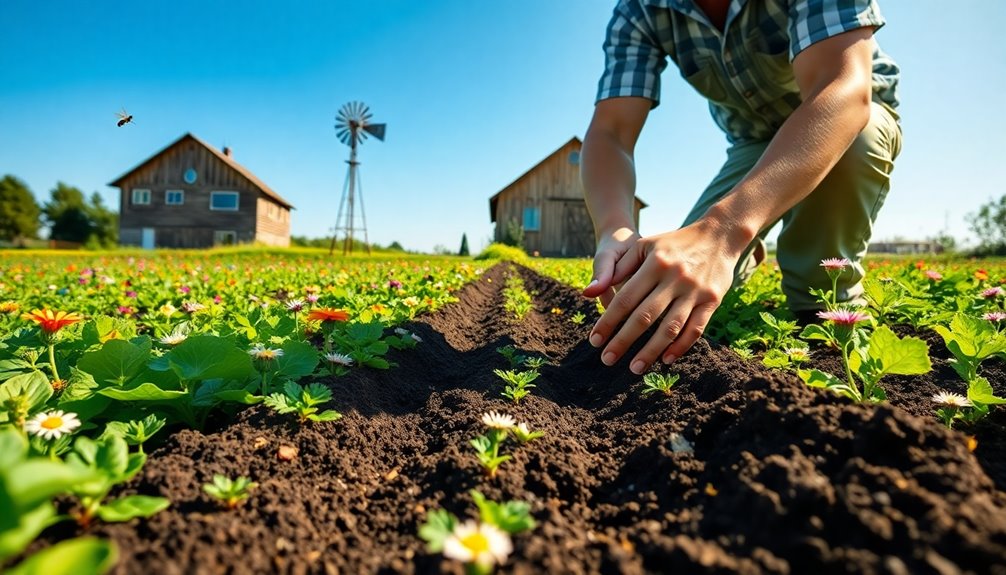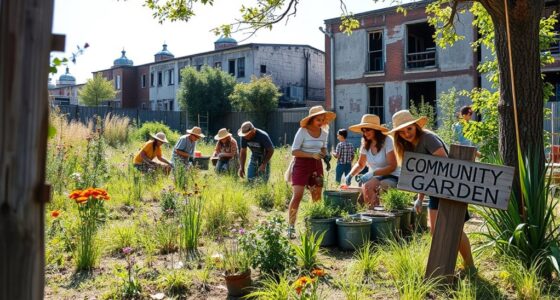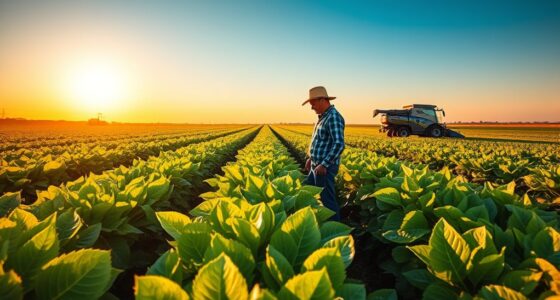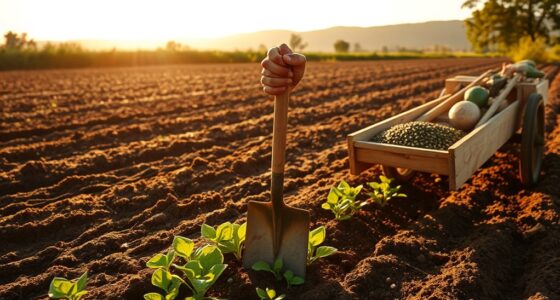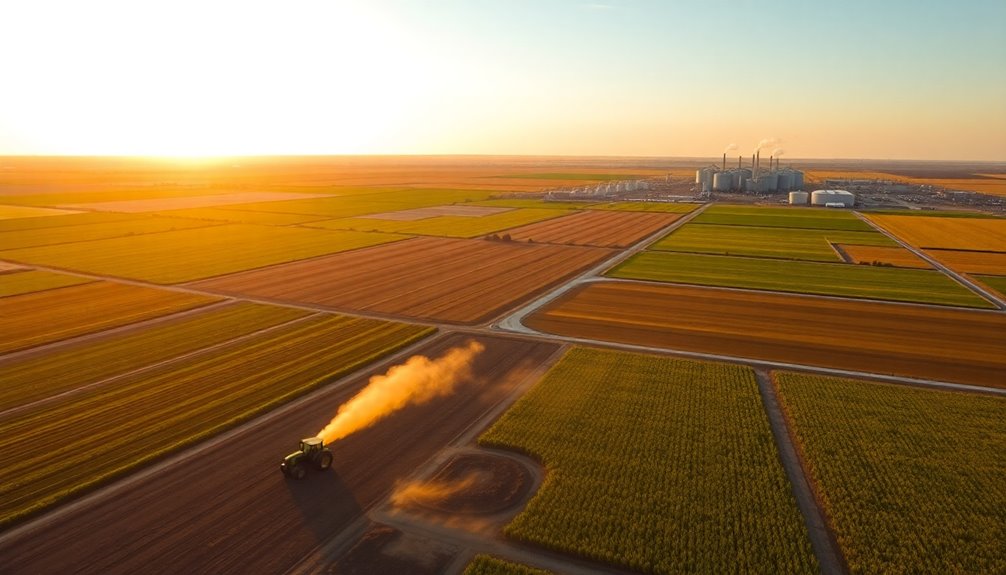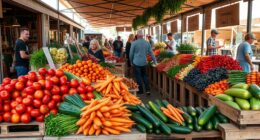Terrace farming is an important agricultural technique that turns sloped land into tiered fields. You create these stepped levels to enhance crop cultivation and reduce soil erosion. This method effectively manages water runoff and maximizes the use of arable land, especially in mountainous areas. Traditionally, it's been essential for communities, particularly in regions like the Andes and Southeast Asia, where it supports sustainable practices and improves food security. More than just a farming method, it reflects cultural significance and traditional knowledge. Stick around, and you'll discover even more about its benefits and challenges.
Key Takeaways
- Terrace farming involves creating stepped levels on sloped land to enhance crop cultivation and minimize soil erosion.
- This agricultural technique is historically rooted in ancient civilizations, notably practiced by the Incas in the Andes.
- It offers environmental benefits by reducing soil erosion, capturing moisture, and promoting biodiversity through unique microhabitats.
- Economically, terrace farming boosts local food security and preserves traditional practices, fostering community identity and cultural heritage.
- Challenges include high labor demands, limited machinery use, and risks from continuous cropping and heavy rainfall.
Definition of Terrace Farming
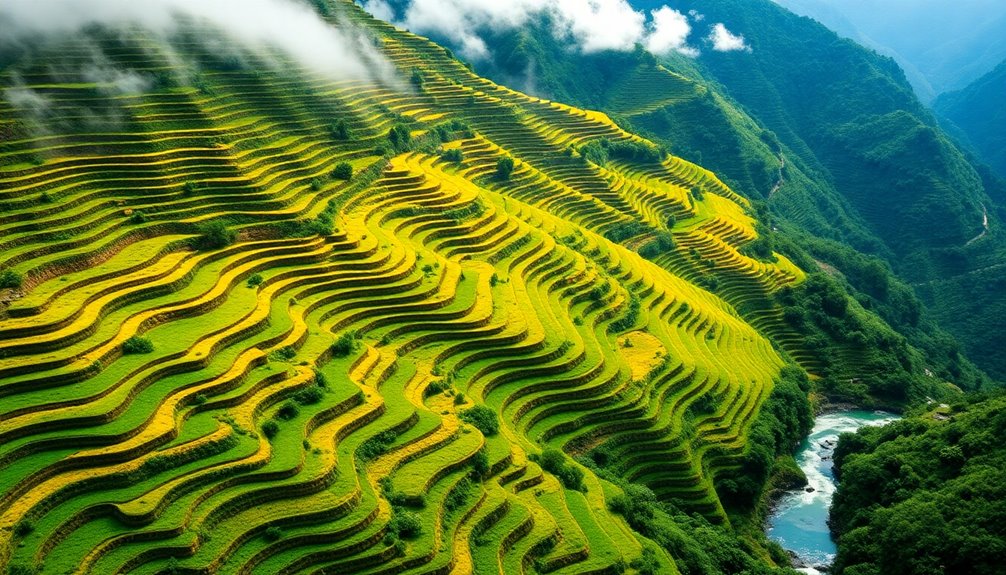
Terrace farming is an agricultural technique that involves creating stepped levels on sloped land, which not only enhances crop cultivation but also minimizes soil erosion and effectively manages water runoff.
By transforming sloped terrain into flat surfaces, you maximize arable land, especially in regions like the Andes Mountains. This method allows for the effective cultivation of various crops, including rice, potatoes, and vegetables, while also preventing soil degradation and conserving water.
As a sustainable agricultural practice, terrace farming plays an essential role in improving food security by stabilizing soil and reducing the risk of landslides.
It demonstrates how communities adapt their agricultural techniques to challenging environments, ensuring resilience and productivity in their farming efforts.
Historical Context of Terrace Farming
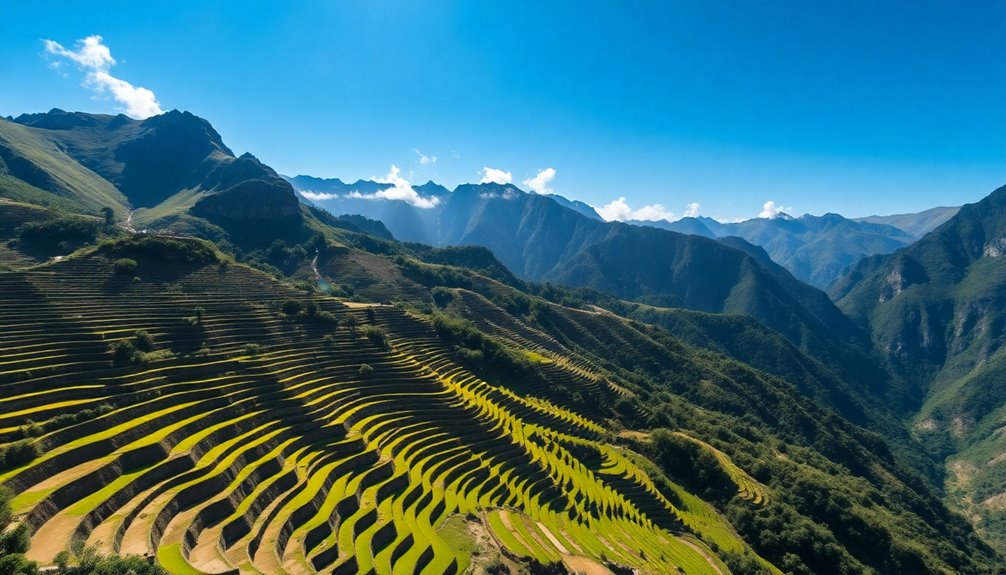
Terrace farming has roots in ancient civilizations, where communities adapted to challenging landscapes to grow crops.
Over the centuries, these techniques evolved, reflecting the ingenuity of cultures in regions like the Andes and Southeast Asia.
As you explore its history, you'll see how these practices shaped sustainable agriculture and influenced local economies.
Ancient Civilizations' Practices
Throughout history, various ancient civilizations have harnessed the power of terrace farming to adapt to their unique environments and improve agricultural yields.
This innovative technique allowed them to cultivate crops in challenging terrains, enhancing soil health and promoting sustainable land use.
- The Incas developed extensive terrace systems in the Andes Mountains for agriculture.
- Ancient China utilized terraces to grow rice in mountainous regions.
- The Greeks employed terraces to cultivate olives and grapes, essential for trade.
- Indigenous tribes in the Philippines have practiced terrace farming, particularly for rice.
- Archaeological findings show terrace farming in pre-Columbian Mesoamerica, boosting agricultural productivity.
These practices reflect the adaptability and ingenuity of ancient civilizations in overcoming environmental challenges.
Evolution Over Centuries
Over the centuries, farmers have transformed the landscape with the clever use of terrace farming, adapting their techniques to suit diverse environments. This agricultural practice has roots in ancient civilizations, particularly in the Andes Mountains and Southeast Asia. The oldest terraces, found in the Philippines, date back to around 2000 BC. In ancient China, farmers developed terrace farming for rice cultivation, greatly boosting food production. The Mediterranean region showcases its rich history with terraces used for grape cultivation, essential for wine production. As environmental conditions changed, terrace farming techniques evolved, integrating local knowledge and innovations.
| Region | Key Agricultural Practices |
|---|---|
| Andes Mountains | Potato and quinoa cultivation |
| Southeast Asia | Rice cultivation |
| Ancient China | Rice cultivation |
| Mediterranean region | Grape cultivation |
| Philippines | Rice and vegetable farming |
Environmental Benefits
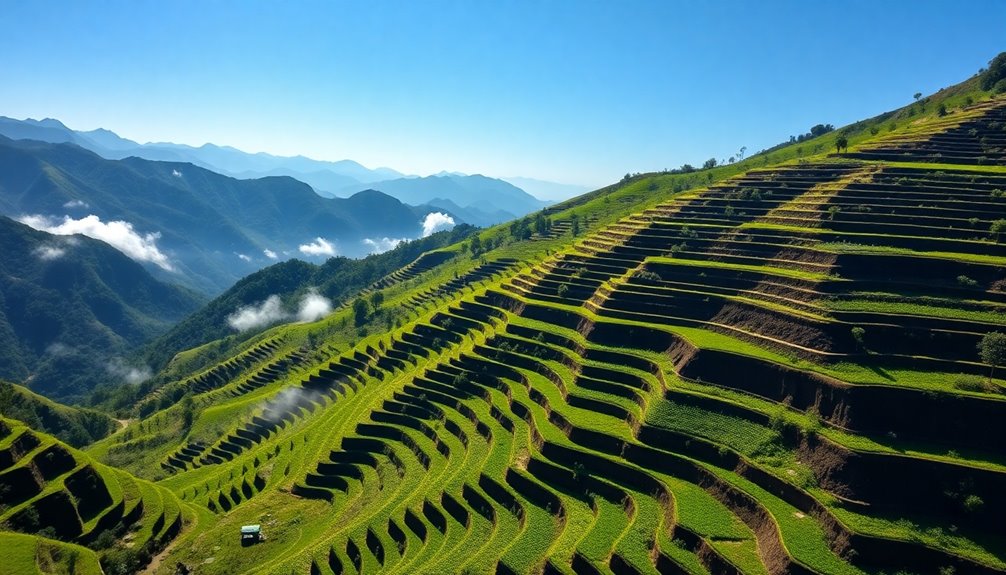
Terrace farming offers impressive environmental benefits that you'll appreciate.
By reducing soil erosion, conserving water, and promoting biodiversity, this method creates a more sustainable agricultural landscape.
You'll find that these practices not only enhance crop growth but also contribute to a healthier ecosystem overall.
Soil Erosion Reduction
One of the key benefits of terrace farming is its ability to greatly reduce soil erosion. This agricultural practice stabilizes soil on sloped land, preventing the loss of topsoil during heavy rains.
The stepped design of terraces slows down water runoff, allowing more water absorption and minimizing erosion from surface flow. By capturing and retaining moisture, terraces help maintain soil structure and fertility, further contributing to reduced soil erosion over time.
Research shows that areas using terrace farming can experience up to a 50% reduction in soil erosion compared to conventional farming methods.
- Stabilizes soil on slopes
- Slows down water runoff
- Captures and retains moisture
- Maintains soil structure
- Reduces topsoil loss
Water Conservation Techniques
Water conservation techniques play an essential role in sustainable agriculture, especially in areas prone to drought.
Terrace farming is a prime example, as it creates flat areas that slow down runoff, allowing water to infiltrate the soil and reducing soil erosion. This stepped design minimizes landslide risks, helping maintain soil moisture and nutrient retention for crops.
By managing water flow through channels and ridges, you can maximize rainwater usage, which is critical in regions with limited resources.
Additionally, terraces create microclimates that enhance moisture retention, fundamental for crop growth. Furthermore, implementing energy-efficient models can contribute to sustainable practices by reducing the overall environmental impact of agricultural operations.
Biodiversity Promotion Benefits
In farming on terraces, you're not just cultivating crops; you're actively enhancing biodiversity within the ecosystem.
Terraced farming creates microhabitats that support various crops and wildlife, promoting ecological stability. This practice allows for diverse crops like rice, potatoes, and vegetables, increasing genetic resilience against pests and diseases.
By stabilizing soil and reducing erosion, terraced systems maintain healthy ecosystems, benefiting a wider range of flora and fauna. Additionally, they facilitate organic farming techniques, avoiding harmful pesticides that threaten non-target species.
The diverse planting strategies improve pollinator populations, enhancing overall agricultural productivity. Moreover, the use of herbal teas as natural pest deterrents aligns with sustainable farming practices, further supporting biodiversity.
- Supports multiple microhabitats
- Stabilizes soil and reduces erosion
- Promotes organic farming practices
- Enhances pollinator populations
- Increases agricultural productivity
Must-Know Facts
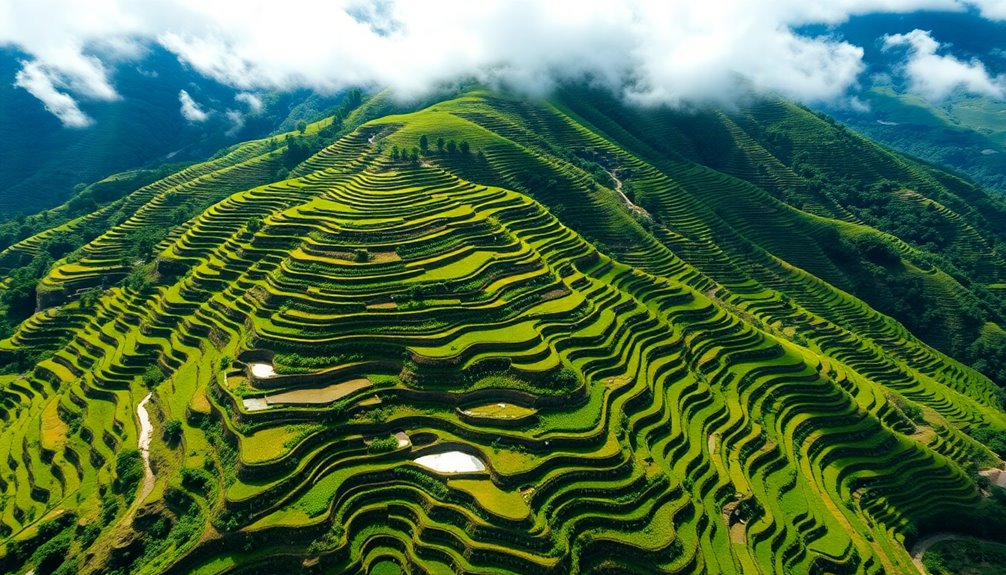
When exploring the world of agriculture, terrace farming stands out as an ingenious solution to the challenges posed by steep, mountainous terrain. Commonly practiced in regions like the Andes Mountains and Southeast Asia, this agricultural practice has adapted over thousands of years.
By constructing stepped levels using local materials, terrace farming helps stabilize the soil and prevent soil erosion. This method effectively manages water runoff, conserving essential water resources and reducing the risk of landslides.
A diverse range of crops grown on terraces, including rice, potatoes, and various vegetables, enhances local food security and promotes biodiversity. Overall, terrace farming exemplifies how human ingenuity can address environmental challenges while supporting sustainable agriculture.
Cultural Significance
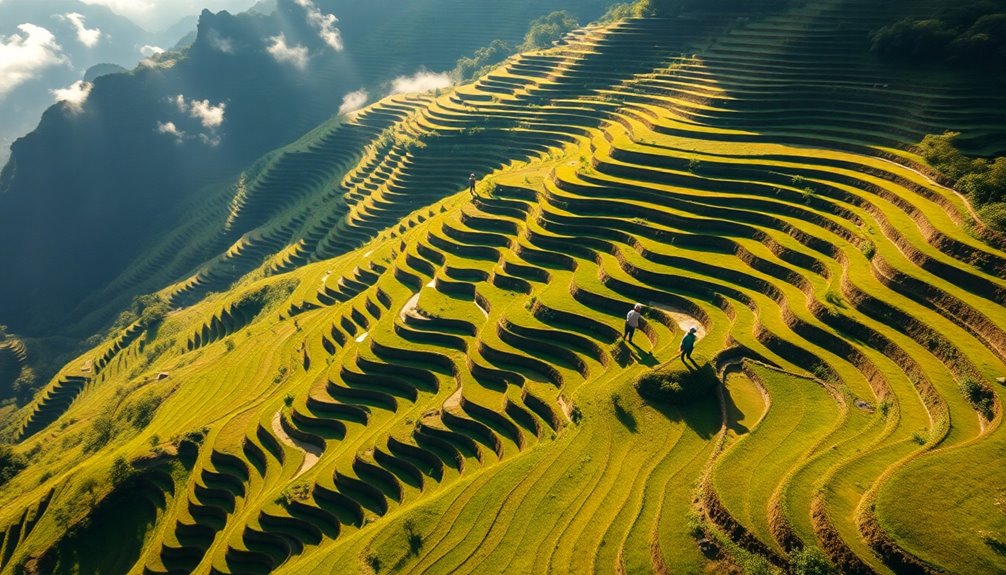
Terrace farming has been woven into the cultural fabric of many communities for centuries, especially in regions like the Andes and Southeast Asia. This agricultural practice holds deep cultural significance as it embodies traditional knowledge and community cooperation, reflecting local adaptations to environmental challenges.
The designs of terraces often symbolize cultural values such as harmony with nature and sustainable land use, making them a form of cultural expression.
- Fosters resilience against climate change
- Preserves traditional agricultural practices
- Enhances community identity and heritage
- Boosts cultural tourism in regions like Bali
- Demonstrates innovation in sustainable land use
Review Questions

Reviewing key concepts about terrace farming can deepen your understanding of its significance and impact.
Consider how this agricultural practice adapts to geography by transforming sloped land into flat areas for crop cultivation.
What're the benefits of terrace farming regarding water conservation and soil erosion reduction?
Reflect on how it enhances food security by maximizing arable land, allowing diverse crops like rice and potatoes to thrive.
Think about the role of terrace farming in promoting biodiversity and community sustainability.
How does it support local economies and food production?
Related Terms
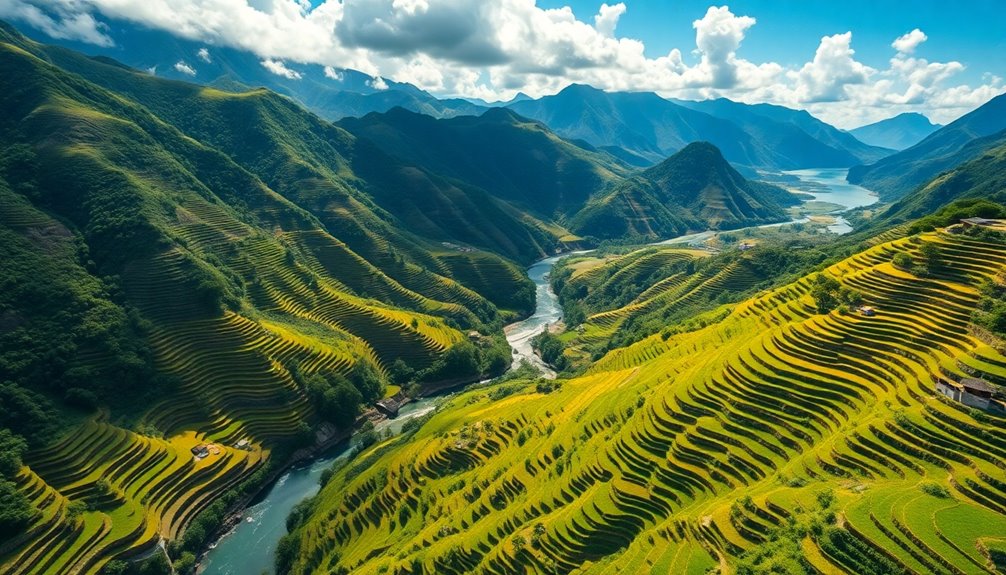
In the context of terrace farming, several related terms highlight its significance and functionality. This agricultural practice is particularly beneficial in hilly or mountainous regions, where it effectively promotes erosion control by stabilizing soil and water.
The integration of irrigation techniques maximizes crop cultivation, even in areas with limited rainfall. Additionally, terrace farming supports agroecology by fostering biodiversity through varied microenvironments, enhancing ecological stability.
The altered microclimate created by terraces can improve growing conditions, further contributing to sustainable agriculture.
- Erosion control
- Biodiversity
- Irrigation
- Agroecology
- Microclimate
Understanding these terms will deepen your appreciation of how terrace farming plays an essential role in sustainable agricultural practices.
Farming Techniques
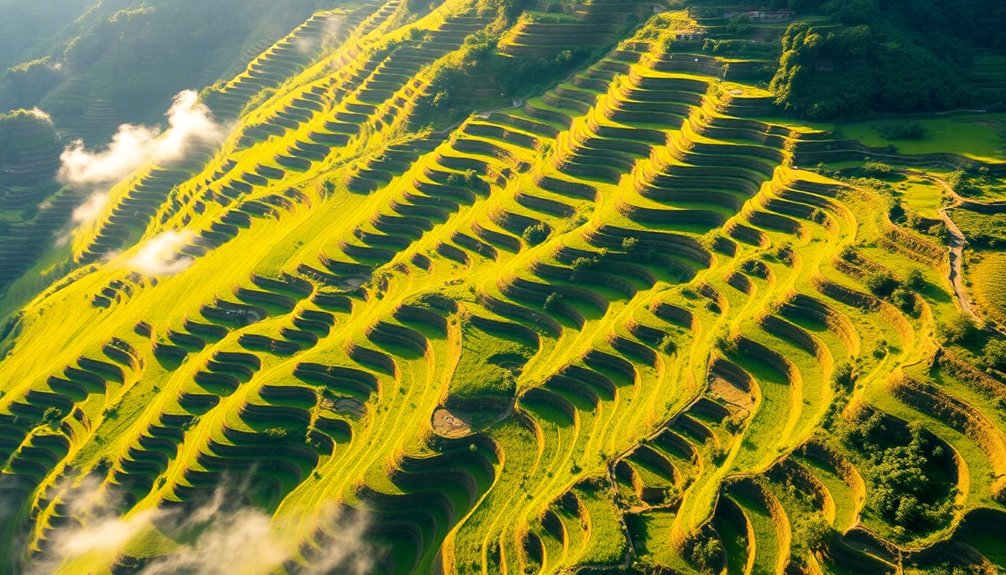
The art of farming techniques in terrace agriculture revolves around creating stepped levels on sloped land, which transforms challenging terrains into productive fields.
This agricultural practice effectively manages water runoff and minimizes soil erosion, making it ideal for hilly regions.
You'll find that constructing and maintaining these terraces can be labor-intensive, often utilizing local materials like stone or earth.
By slowing down water movement, terraces allow better absorption, reducing landslide risks.
Common crops for cultivation include rice and potatoes, which thrive in the stable, moist environments these terraces provide.
The techniques in terrace farming can vary based on local climate and soil conditions, ensuring both sustainability and optimized agricultural output for diverse regions.
Challenges and Limitations
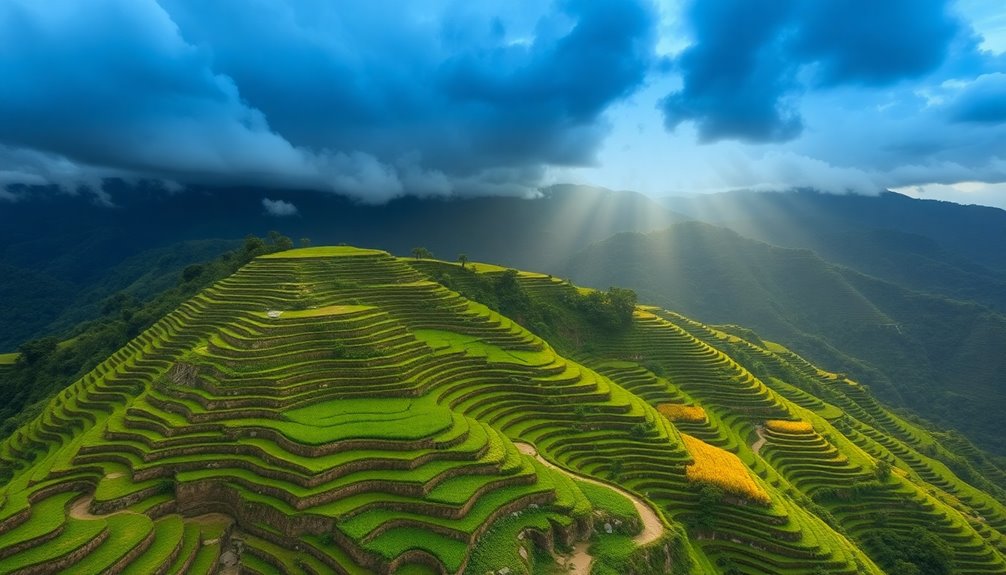
Terrace farming presents several challenges that can hinder its effectiveness and sustainability.
You'll find that this method requires significant labor and resources for both construction and ongoing maintenance. The steep slopes can limit the types of machinery available, leading to more manual labor and potential inefficiencies.
Additionally, soil fertility may decline over time due to nutrient depletion from continuous cropping. The risk of landslides is also a concern, especially with heavy rainfall, which can damage crops and infrastructure.
Finally, terrace farming may not adequately address broader environmental issues like deforestation and climate change, as it primarily focuses on localized agricultural practices.
- High labor and resource demands
- Limited machinery use
- Soil fertility decline
- Landslide risks
- Inadequate environmental solutions
Frequently Asked Questions
What Is Terrace Farming in Geography?
Terrace farming, in geography, refers to the practice of carving stepped levels into sloped land to create flat areas for growing crops.
You'll find it in mountainous regions where traditional farming isn't feasible. This method helps reduce soil erosion and manage water runoff, making it more sustainable.
What Is the Definition of Farming AP Human Geography?
Think of farming as the heartbeat of human civilization.
In AP Human Geography, farming refers to the systematic cultivation of crops and livestock for food, fiber, and other products essential for sustaining populations and economies.
You'll explore various practices, like subsistence and commercial farming, and learn how environmental factors like soil and climate shape agricultural productivity.
Understanding these concepts helps you appreciate farming's role in cultural landscapes and sustainable development.
What Is the Definition of Terrace Farming Where Is It Practiced in China and Why?
Terrace farming's a method where you create stepped levels on hilly land to grow crops efficiently.
In China, it's practiced mainly in Yunnan province and the Longsheng Rice Terraces. This technique helps you manage soil erosion and water runoff, maximizing arable land in mountainous areas.
What Is the Simple Definition of Terracing?
When you think of farming on a steep hill, terracing comes to mind.
It's a method where you create stepped levels on sloped land to grow crops more efficiently. By doing this, you not only prevent soil erosion but also manage water runoff better.
This technique helps absorb moisture in the soil, making it perfect for hilly regions.
It's a smart way to adapt to challenging landscapes while promoting sustainable agriculture.
Conclusion
In the grand tapestry of agriculture, terrace farming stands as a resilient mountain goat, skillfully maneuvering the steep slopes of sustainability. By carving out flat patches on hillsides, it transforms challenging landscapes into thriving farms, much like a wise gardener tending to nature's complexities. As you explore this ancient practice, remember that every step you take on this fertile ground echoes a legacy of ingenuity, harmony, and respect for the earth. Embrace the journey and cultivate your understanding!


